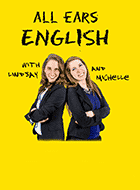Are you sometimes confused on how to use the word “so?”
It has multiple uses and meanings in English!
Listen to today’s episode and learn how to use this word to sound more like a native English speaker.
So, do you know how to use this word?
Michelle asks Aubrey if she is going to do anything fun this weekend.
Aubrey says “I think so. We have plans to have some friends over to swim.”
She adds that she loves playing volleyball in the swimming pool.
Today’s episode is part two of a two-part series.
The first episode of this series is AEE: Avoid This Mistake With Stacked Adjectives.
Aubrey and Michelle are sharing two other ways to use “so” that are common in business English
So, here is how you do it
The word ‘so’ is versatile and can be used in many different ways.
Aubrey and Michelle share tips today about adding it to your daily conversations at work.
This word is also common in everyday personal interactions.
You need it for both!
#1: Conjunction for a result or decision
‘So’ is used to introduce a clause that explains the result of a previous statement or the decision taken based on it.
Examples:
- We can’t afford any delays, so I’ll talk to the vendor and set a hard deadline.
- They are severely in need of funds, so I think they will accept what the investor offers.
In this sample, the word ‘so’ has the same meaning as hence, therefore, or thus.
But these are quite a bit more formal.
In spoken English ‘so’ is much more commonly used even at work.
Reserve the other ways to use it for formal writing.
Another tip is to combine simple sentences so that speaking and writing flows more smoothly.
Use conjunctions like “so” to do this.
#2: To express agreement or confirmation
‘So’ can be used at the end of a sentence to express agreement or confirmation.
Here are some examples to show you how to use ‘so’ as a confirmation.
Examples:
- I think so.
- I guess so.
In the first example, it means “I think the thing that was just mentioned”
In the second example, it means “I think that’s probably true”
Now for the way where you’re using ‘so’ as an agreement, here are examples using mini-roleplays.
Mini roleplay #1:
Aubrey: I want to check out that lunch spot around the corner.
Michelle: So do I! Let’s go tomorrow!
Mini roleplay #2:
Aubrey: They were worried the deal wouldn’t go through.
Michelle: So were we. Really glad it all worked out.
Roleplay
Here is a quick roleplay from Aubrey and Michelle to show you how you can use the lesson from today’s episode in your own daily conversations.
In this scenario, Aubrey and Michelle are coworkers in a meeting.
Michelle: It looks like everyone is here, so we can begin the meeting.
Aubrey: The client moved the launch date up by two weeks, so we need to speed up the final phase of the project.
Michelle: That’s a tight schedule. We’re still waiting on the final content from the marketing team, so we’ll need to follow up with them immediately.
Aubrey: I can ask Mark to do that. He’s meeting with them tomorrow, right?
Michelle: I think so.
Takeaway
We use “so” in so many ways in English!
The tips in this series will help you use it in three different ways with confidence and avoid a common mistake.
From showing results to expressing agreement, learning how to use “so” naturally can make your English sound more fluent and conversational, especially at work.
Practice these patterns from today’s episode and start using them in your own business English conversations.
It’s a small word that makes a big impact, so don’t miss the chance to master it!
Do you feel more confident using “so” now?
We’d love to hear your thoughts in the comment section.



